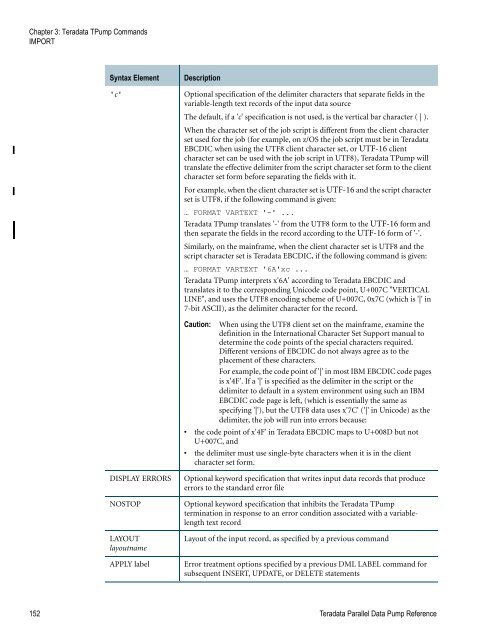Teradata Parallel Data Pump
Teradata Parallel Data Pump Reference - Teradata Developer ...
Teradata Parallel Data Pump Reference - Teradata Developer ...
- No tags were found...
Create successful ePaper yourself
Turn your PDF publications into a flip-book with our unique Google optimized e-Paper software.
Chapter 3: <strong>Teradata</strong> T<strong>Pump</strong> Commands<br />
IMPORT<br />
Syntax Element<br />
'c'<br />
Description<br />
Optional specification of the delimiter characters that separate fields in the<br />
variable-length text records of the input data source<br />
The default, if a 'c' specification is not used, is the vertical bar character ( | ).<br />
When the character set of the job script is different from the client character<br />
set used for the job (for example, on z/OS the job script must be in <strong>Teradata</strong><br />
EBCDIC when using the UTF8 client character set, or UTF-16 client<br />
character set can be used with the job script in UTF8), <strong>Teradata</strong> T<strong>Pump</strong> will<br />
translate the effective delimiter from the script character set form to the client<br />
character set form before separating the fields with it.<br />
For example, when the client character set is UTF-16 and the script character<br />
set is UTF8, if the following command is given:<br />
… FORMAT VARTEXT '-' ...<br />
<strong>Teradata</strong> T<strong>Pump</strong> translates '-' from the UTF8 form to the UTF-16 form and<br />
then separate the fields in the record according to the UTF-16 form of '-'.<br />
Similarly, on the mainframe, when the client character set is UTF8 and the<br />
script character set is <strong>Teradata</strong> EBCDIC, if the following command is given:<br />
… FORMAT VARTEXT '6A'xc ...<br />
<strong>Teradata</strong> T<strong>Pump</strong> interprets x'6A' according to <strong>Teradata</strong> EBCDIC and<br />
translates it to the corresponding Unicode code point, U+007C "VERTICAL<br />
LINE", and uses the UTF8 encoding scheme of U+007C, 0x7C (which is '|' in<br />
7-bit ASCII), as the delimiter character for the record.<br />
Caution: When using the UTF8 client set on the mainframe, examine the<br />
definition in the International Character Set Support manual to<br />
determine the code points of the special characters required.<br />
Different versions of EBCDIC do not always agree as to the<br />
placement of these characters.<br />
For example, the code point of '|' in most IBM EBCDIC code pages<br />
is x'4F'. If a '|' is specified as the delimiter in the script or the<br />
delimiter to default in a system environment using such an IBM<br />
EBCDIC code page is left, (which is essentially the same as<br />
specifying '|'), but the UTF8 data uses x'7C' ('|' in Unicode) as the<br />
delimiter, the job will run into errors because:<br />
• the code point of x'4F' in <strong>Teradata</strong> EBCDIC maps to U+008D but not<br />
U+007C, and<br />
• the delimiter must use single-byte characters when it is in the client<br />
character set form.<br />
DISPLAY ERRORS<br />
NOSTOP<br />
LAYOUT<br />
layoutname<br />
APPLY label<br />
Optional keyword specification that writes input data records that produce<br />
errors to the standard error file<br />
Optional keyword specification that inhibits the <strong>Teradata</strong> T<strong>Pump</strong><br />
termination in response to an error condition associated with a variablelength<br />
text record<br />
Layout of the input record, as specified by a previous command<br />
Error treatment options specified by a previous DML LABEL command for<br />
subsequent INSERT, UPDATE, or DELETE statements<br />
152 <strong>Teradata</strong> <strong>Parallel</strong> <strong>Data</strong> <strong>Pump</strong> Reference









